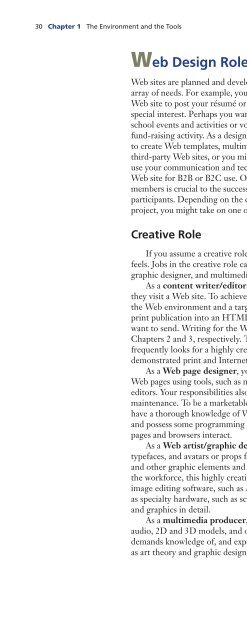(Shelly Cashman Series) Gary B. Shelly, H. Albert Napier, Ollie N. Rivers-Web design_ introductory concepts and techniques -Cengage Learning (2008)
Create successful ePaper yourself
Turn your PDF publications into a flip-book with our unique Google optimized e-Paper software.
30 Chapter 1 The Environment <strong>and</strong> the Tools<br />
<strong>Web</strong> Design Roles<br />
<strong>Web</strong> sites are planned <strong>and</strong> developed within a wide range of environments to meet a vast<br />
array of needs. For example, you might decide to work independently to create a personal<br />
<strong>Web</strong> site to post your résumé or to demonstrate your passion for a favorite hobby or<br />
special interest. Perhaps you want to work with friends to create a <strong>Web</strong> site to promote<br />
school events <strong>and</strong> activities or volunteer to help create a <strong>Web</strong> site to support a community<br />
fund-raising activity. As a <strong>design</strong> professional, you might choose to work independently<br />
to create <strong>Web</strong> templates, multimedia elements, or 3D virtual world animations for sale at<br />
third-party <strong>Web</strong> sites, or you might be a member of a <strong>Web</strong> development team where you<br />
use your communication <strong>and</strong> technical skills to help develop a sophisticated commercial<br />
<strong>Web</strong> site for B2B or B2C use. Ongoing communication between <strong>Web</strong> development team<br />
members is crucial to the success of any <strong>Web</strong> site <strong>design</strong> project that involves multiple<br />
participants. Depending on the circumstances <strong>and</strong> the complexity of the <strong>Web</strong> development<br />
project, you might take on one or more of the following <strong>Web</strong> <strong>design</strong> roles.<br />
Creative Role<br />
If you assume a creative role, your focus primarily will be on how the site looks <strong>and</strong><br />
feels. Jobs in the creative role category include content writer/editor, <strong>Web</strong> <strong>design</strong>er, artist/<br />
graphic <strong>design</strong>er, <strong>and</strong> multimedia producer.<br />
As a content writer/editor, you create <strong>and</strong> revise the text that visitors read when<br />
they visit a <strong>Web</strong> site. To achieve your <strong>Web</strong> site’s purpose, you must write specifically for<br />
the <strong>Web</strong> environment <strong>and</strong> a targeted <strong>Web</strong> audience. Text simply cut <strong>and</strong> pasted from a<br />
print publication into an HTML document will not effectively deliver the message you<br />
want to send. Writing for the <strong>Web</strong> environment <strong>and</strong> targeting an audience are detailed in<br />
Chapters 2 <strong>and</strong> 3, respectively. To fill a content writer/editor position, an employer<br />
frequently looks for a highly creative applicant with a liberal arts background <strong>and</strong><br />
demonstrated print <strong>and</strong> Internet writing experience.<br />
As a <strong>Web</strong> page <strong>design</strong>er, your primary role is to convert text, images, <strong>and</strong> links into<br />
<strong>Web</strong> pages using tools, such as markup languages; CSS; <strong>and</strong> text, HTML, <strong>and</strong> WYSIWYG<br />
editors. Your responsibilities also might include graphic <strong>design</strong> <strong>and</strong> <strong>Web</strong> site setup <strong>and</strong><br />
maintenance. To be a marketable <strong>Web</strong> page <strong>design</strong>er, you must communicate effectively,<br />
have a thorough knowledge of <strong>Web</strong> page <strong>design</strong> technologies, have graphic <strong>design</strong> talent,<br />
<strong>and</strong> possess some programming skills. This role requires a solid underst<strong>and</strong>ing of how <strong>Web</strong><br />
pages <strong>and</strong> browsers interact.<br />
As a <strong>Web</strong> artist/graphic <strong>design</strong>er, you create original art such as logos, stylized<br />
typefaces, <strong>and</strong> avatars or props for 3D virtual worlds. You also might prepare photographs<br />
<strong>and</strong> other graphic elements <strong>and</strong> re<strong>design</strong> print publications for the <strong>Web</strong> environment. In<br />
the workforce, this highly creative role dem<strong>and</strong>s experience with high-end illustration <strong>and</strong><br />
image editing software, such as Adobe Illustrator CS3 ® or Adobe Photoshop CS3 ® , as well<br />
as specialty hardware, such as scanners <strong>and</strong> digital cameras. Chapter 5 discusses typeface<br />
<strong>and</strong> graphics in detail.<br />
As a multimedia producer, you <strong>design</strong> <strong>and</strong> produce animation, digital video <strong>and</strong><br />
audio, 2D <strong>and</strong> 3D models, <strong>and</strong> other media elements to include in a <strong>Web</strong> site. This role<br />
dem<strong>and</strong>s knowledge of, <strong>and</strong> experience with, sophisticated hardware <strong>and</strong> software, as well<br />
as art theory <strong>and</strong> graphic <strong>design</strong> principles.


